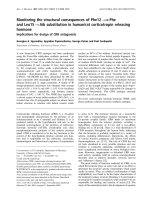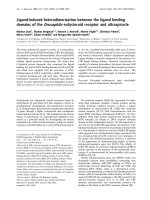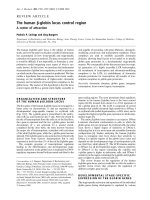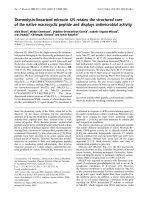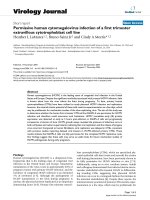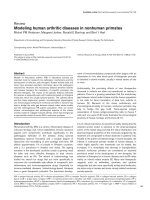Báo cáo y học: " Monitoring human cytomegalovirus infection with nested PCR: comparison of positive rates in plasma and leukocytes and with quantitative PCR" doc
Bạn đang xem bản rút gọn của tài liệu. Xem và tải ngay bản đầy đủ của tài liệu tại đây (248.79 KB, 7 trang )
RESEARC H Open Access
Monitoring human cytomegalovirus infection
with nested PCR: comparison of positive rates in
plasma and leukocytes and with quantitative PCR
Shu Zhang
1,3
, Yi-Hua Zhou
2,3
, Lei Li
2
, Yali Hu
1,3*
Abstract
Background: Human cytomegalovirus (HCMV) infection poses a significant healt h threat to immunocompromised
individuals. Here we performed this study to set up a highly sensitive nested PCR method applicable for detecting
HCMV infection in high-risk individuals. In this work, 106 blood specimens from 66 patients with potential HCMV
infection were obtained. Total DNA was extracted separately from plasma and peripheral blood leukocytes (PBL) of
each sample. HCMV DNA was detected in parallel by nested PCR and quantitative real-time PCR (qRT-PCR), and the
results were compared.
Results: Serial dilution test revealed that the detection limit of nested PCR was 180 copies/ml. The nested PCR
showed a higher positive rate than qRT-PCR (34.9% vs. 12.3%, p < 0.001). The positive rate of nested PCR based on
PBL DNA was significa ntly higher than that based on plasma DNA (34.9% vs. 18.9%, p = 0.002). Of the 14 pa tients
with serial samples, 11 were positive for HCMV DNA in PBL while only 7 were positive in plasma. Moreover, for
each patient, nested PCR using PBL DNA also detected more positive samples than that using plasma DNA.
Conclusion: Combined use of nested PCR with PBL DNA is highly sensitive in defining HCMV infection. This assay
is particularly useful in the case of quantification not essential.
Background
Human cytomegalovirus (HCMV), an opportunistic
pathogen, is ubiquitously distributed in human popula-
tion. The seroprevalence of HCMV in adults ra nges
from 55% [1] in developed countries to as high as over
90% [2,3] in developing countries like China. In immu-
nocompetent persons, HCMV usually just causes a
latent infection with few obvious lesions, but it poses a
significant health threat to immunocompromised indivi-
duals, such as allograft o rgan transplant reci pients,
AIDS patients and chemotherapy recipients. Addition-
ally, the viral intrauterine transmiss ion to fetus can lead
to stillbirth, abortion, and mental retardation. Thus the
availability of a highly sensitive test capable of detecting
HCMV infection for these populations is of great
significance.
Although the detection of pp65 antigen on peripheral
blood leukocytes provides early diagnosis, its sensitivity,
16-68% as reported [4,5], is not so satisfied. Polymerase
chain reaction (PCR) has been proved to be a sensitive
and effective technique in defining HCMV infection.
Quantitative real-time PCR (qRT-PCR) is widely applied
for its preponderance in quantifying the viral load and
reducing the probability of contamination by reacting in
a closed system. Nested PCR uses two amplification
rounds with the two pairs of “external” and “internal”
primers, hence the sensitivity and specificity are
improved significantly. However, it is still a subject
being debated to determine which of the two is more
sensitive and suitable for monitoring HCMV infection,
since the results of many relevant reports are contradic-
tory [6-10].
In addition to detection assay, it has been documented
that diff erent blood components also affect the positive
rate of HCMV infection [11,12]. Which type of blood
fractions, p eripheral blood leukocytes (PBL) or plasma,
is optimal? There has been no consensus yet. S ome
reports [12-14] suggest that leukocyte-based tests are
superior for detecting HCMV DNA. On the other hand,
* Correspondence:
1
Department of Obstetrics and Gynecology, Nanjing Drum Tower Hospital,
Nanjing University Medical School, Nanjing, China
Zhang et al. Virology Journal 2010, 7:73
/>© 2010 Zhang et al; lice nsee BioMed Central Ltd. This is an Open Access article distributed under the terms of the Creative Commons
Attribu tion License ( which permits unrestricted use, distribution, and repro duction in
any medium, provided the original work is properly cited.
several studies show that plasma/serum positivity is
more correlated with active infection and the processing
of plasma is easier [15,16].
Theaimofourstudywastosetupahighlysensitive
assay applicable to detecting HCMV infection in high-
risk patients. In the present study, two PCR techniques,
qRT-PCR and nested PCR, and different materials,
plasma and PBL, were compared in de tecting HCMV
DNA. The serological assays including IgM, IgG, and
IgG avidity index (AI) tests were also performed to ver-
ify the results of PCR, since Lutz et al [17,18] have pro-
posed that a low IgG AI is still meaningful in identifying
primary infection even for immunosuppressed patients.
Results
The specificity and sensitivity of nested PCR
To determine the specificity and sensitivity of nested
PCR, we detected HCMV DNA in one viral culture
supernatant, 4 plasma specimens from the confirmed
patients, and 4 plasm as from healthy adults. As
expected, HCMV DNA was positive in the culture
supernatant and in th e 4 patients’ plasma, while none of
the 4 healthy persons’ specimen presented a specific
293-bp fragment (data not shown), suggesting the reli-
able specificity of this nested PCR. One positive plasma
sample, quantifi ed by qRT-PCR, underwent 2-fold serial
dilution and amplification by nested PCR. T he HCMV
DNA was still detected by nested PCR even though t he
viral load was as low as 180 copies/ml, indicating that
nested PCR is more sensitive than qRT-PCR, in which
the detection limit was 500 copies/ml according to the
manufacture’s instructions.
The positive rate of HCMV DNA in plasma and PBL
detected by qRT-PCR and nested PCR
To evaluate the detection efficacy of different PCR tech-
niques, we simultaneously perf ormed nested PCR and
qRT-PCR for the 106 specimens from 66 patients. To
verify the contribution of different materials to the posi-
tive rate, we also det ected the viral D NA in both the
plasma and PBL of each specimen. As shown in Table
1, all the 13 positive samples by qRT-PCR were also
positive by nested PCR both with plasma and PBL. With
nested PCR, 18 of 20 positive samples by plasma DNA
were also positive by leukocyte DNA; moreover, 19
negative samples by plasma DNA were positive by leu-
kocyte DNA. Together, the sensitivity of nested PCR
was higher than that of qRT-PCR (34.9% vs. 12.3%, p <
0.001), and PBL was superior to plasma with higher sen-
sitivity (34.9% vs. 18.9%, p = 0.002).
Agreement in the three processes (qRT-PCR with
PBL, nested PCR with plasma, and nested PCR with
PBL) was observed in 80 (75.5%) samples, including 13
positive samples and 67 negative samples. When nested
PCR with PBL was considere d as the reference techni-
que, the sensitivity, specificity, positive predictive value,
and negative predictive value of nested PCR with plasma
and qRT-PCR with PBL, and their respective concor-
dance to nested PCR with PBL were shown in Table 2.
The three techniques had similar specificity and positive
predicti ve value, yet nested PCR with PBL exhibited the
highest sensitivity and negative predictive value.
Of the 14 cases with serial samples, 7 patients each
presented at least one positive specimen by nested PCR
with plasma. However, when we chose PBL as the detec-
tion material, additional 4 patients were found to be
positive (Table 3). Moreover, for each individua l, nested
PCR with PBL detected more positive samples than that
using plasma DNA. These re sults suggested that PBL
was the preferred material in improving the sensitivity.
The consistency of nested PCR and serological assays
Among the 66 pa tients with single samples, 5 had no
sufficient plasma for further IgG, IgM and IgG AI detec-
tion. Thus 61 patients underwent the serological tests;
all were positive for HCMV IgG. For patients with serial
samples, the criterion for primary infection was: (1) all
the consecutive specimens had an AI value < 30%, or
(2) the AI of the initial specimen was < 30%, then it
increased to > 30% in subsequent samples.
According to the results of nested PCR with either
plasma or PBL, the 61 subjects were divided into posi-
tive group (24 patients) and negative group (37
patients). Considering the serological evidence for recent
infection in the nested PCR positive group, 5 patients
presented positive IgM only, 6 had low AI only, and 5
Table 1 Positive rate of HCMV DNA in plasma and PBL by qRT-PCR and nested PCR
Technique with material
No. of positive cases (%) (N = 106)
qRT-PCR with PBL 13 (12.3%) Nested PCR with plasma 20 (18.9%
a
)
Positive Negative Positive Negative
Nested PCR with PBL
37 (34.9%
b, c
)
Positive 13 24 18 19
Negative 0 99 2 67
a
Compared to the positive rate by qRT-PCR with PBL, p = 0.016.
b
Compared to the positive rate by qRT-PCR with PBL, p < 0.001.
c
Compared to the positive rate by nested PCR with plasma, p = 0.002.
Zhang et al. Virology Journal 2010, 7:73
/>Page 2 of 7
were positive for IgM and had low AI. On the other
hand, in the nested PCR negative group, 2 were solely
IgM positive, 2 had low AI, and only 1 showed for both
(Table 4). The results of serological assay s and nested
PCR were consistent in 78.7% patients, including 16
concordant positive patients and 32 concordant negative
patients. Compared with those negative in nested PCR,
the nested PCR positive group had significant hig her
probability (66.7% vs. 13.5%, p < 0.01) to be IgM posi-
tive and/or to have low AI.
Discussion
In the present study, we found that nested PCR detected
more samples positive for HCMV DNA than qRT-PCR,
andnestedPCRusingPBLDNAhadthehighestposi-
tive rate. Therefore, nestedPCRbasedonPBLDNAis
the most sensitive method for detecting HCMV DNA.
False positive caused by cross con tamination is a main
problem of nested PCR. To avoid such cross contamina-
tion, we strictly adopted precautionary measures [19],
such as processing meticulously, introducing negative
controls, extracting and amplifying the DNA in different
rooms, and changing gloves frequently. Additionally, the
positives of nested PCR were confirmed to some extent
by the serological assays (Table 4). Furthermore, we
performed another nested PCR using a different set of
primers and obtained the identical results (data not
shown). Therefore, the high sensitivity o f this nested
PCR i n detecting HCMV DNA observed in the study is
reliable.
Our findings are in agreement with the previous
observation that nested PCR is more sensitive than
qRT-PCR [6,7]. By contrast, several studies [8,9]
reported the opposite results. Additionally, the similar
sensitivity or discordant results between qRT-PCR and
nested PCR have also been documented by other inves-
tigators [10,20,21]. One reason for the situation of “dif-
ferent study, different result” may be different patient
groups investigated by different studies. Mhiri et al [22]
have suggested that t he performance of diagnostic tests
may be affected by transplant patients’ different immu-
nological responses to different transplant (renal, bone
marrow, etc.). However, in the present study, we evalu-
ated all the patients as a whole instead of dividing them
into subgroups according to their primary d iseases,
because we aimed to define a routine test competent
enough for most, if not all, patients. Actually, it is
impracticable to change the detection for every specific
disease during one laboratory’s daily work. In addition
to the targeted population, other factors such as the
Table 2 Sensitivity, specificity and predictive values of nested PCR with plasma and qRT-PCR with PBL
Process Sensitivity (%) Specificity (%) Positive predictive
value (%)
Negative predictive
value (%)
Concordance to nested
PCR with PBL (%)
qRT-PCR with PBL 35.1 100 100 74.2 77.4
Nested PCR with plasma 48.6 97.1 90.0 77.9 80.2
Nested PCR with PBL
a
100 100 100 100 –
a
Nested PCR with PBL was considered as the reference technique in detecting HCMV DNA.
Table 3 Positive frequency of serial samples by qRT-PCR with PBL, nested PCR with PBL, and nested PCR with plasma
Positive/Total
qRT-PCR with PBL Nested PCR with PBL Nested PCR with plasma
A (bone marrow transplant recipient) 3/8 5/8 3/8
B (acute myeloblastic leukemia) 0/6 3/6 0/6
C (chronic myeloblastic leukemia) 0/3 2/3 0/3
D (chronic myeloblastic leukemia) 2/8 2/8 2/8
E (systemic lupus erythematosus) 1/3 2/3 1/3
F (chickenpox) 3/3 3/3 3/3
G (acute non-lymphocytic leukemia) 0/6 2/6 0/6
H (interstitial pneumonia) 1/2 2/2 1/2
I (acute non-lymphocytic leukemia) 0/4 0/4 0/4
J (fever of undetermined origin) 0/3 0/3 0/3
K (fever of undetermined origin) 1/2 2/2 1/2
L (chronic renal failure) 1/2 2/2 2/2
M (acute myelomonocytic leukemia) 0/2 1/2 0/2
N (acute non-lymphocytic leukemia) 0/2 0/2 0/2
Zhang et al. Virology Journal 2010, 7:73
/>Page 3 of 7
PCR primers [23,24] and the DNA extract ion technique
[25] may also influence the amplification efficacy. As
Bastien et al [26] conclude that the PCR is not an iso-
lated technique; instead, it involves a range of techni-
ques, which might affect the outcome depending on a
variety of factors. For this study, we believe that more
reaction cycles in nested PCR, almost twice of that in
qRT-PCR, is the main explanation for the higher
sensitivity.
The detection capacity of the qRT-PCR in this investi-
gation appears to be inferior to that of some recorded
qRT-PCR [27,28]. However, a recent multi-center
research [29] has indicated that various HCMV DNA
quantitative assays, including both commercial reagents
and laboratory-developed assays, are generally not sensi-
tive in detecting viral loads lower than 1000 copies/ml,
irrespective of their reported detection limits. Another
limitation of this study is that the sample size was rela-
tively small; nevertheless, this study contained prospec-
tive serial samples in which HCMV DNA w as detected
more frequently by nested PCR than by qRT-PCR
(Table 3).
Although qRT-PCR has advantages in quantification,
automation, and time savings [30,31], nested PCR is still
clinically significant in some settings. Nested PCR is sui-
table for small number of samples, especially for situa-
tions in which quantificatio n is not essential. For
examples, detection of HCMV DNA in fetuses or new-
borns is sufficiently to diagnose an ongoing active infec-
tion. Additionally, nested PCR does offer benefits for
developing countries because of its low cost.
With appropriate materials adopted in nested PCR,
our results demonstrated that positive rate of HCMV
DNA i n PBL was much higher than that in plasma
(34.9% vs. 18.9%, p = 0.002, Table 1), which is in accor-
dance with the reported data [13,14,32], although similar
sensitivities of plasma and PBL were referred in Ye et
al’ s [33] and Banan et al’ s reports [34]. Two reasons
may contribute to t he higher sensitivity of using PBL
DNA: (1) the concentration of DNA extracted from PBL
should be much higher than th at from 200 μlplasma,
and (2) with the biological characteristics of latent infec-
tion, HCMV may be harbored in PBL [35]; when the
virus in PBL replicates at a low level, very a few viruses
are released into plasma, causing the lower sensitivity of
using plasma DNA.
It is considered that positive DNA in serum/plasma is
connected more closely with symptomatic infection
[15,16], because serum/plasma DNA reflects disruption
of host cells caused by active viral replication. In other
words, it seems that PCR using PBL DNA is not suitable
for diagnosing active CMV infection, because healthy
adults with the latent infection may harbor CMV in
their leukocytes. Nevertheless, for immunosuppression
patients, the risk of the so-called “ latency” to be acti-
vated is highly possible. Therefore the early detection of
HCMV DNA is especially important for reminding clini-
cians to be aware of the possible reactivation and to
carefully follow-up viral load kinetics. As indicated by
relevant studies [31,32,36], monitoring HCMV DNA in
PBL is helpful in anticipating viral replication. In our
study, four patients were negative for HCMV DNA in
plasma but positive for DNA in PBL (Table 3), indicat-
ing the high sensitivity by nested PCR with PBL. On the
other hand, the negative result dete cted by nested PCR
with PBL may be he lpful in ruling out HCMV infection,
since its negative predictive value is very high (Table 2).
Conclusion
In summary, we confirmed that nested PCR based on
PBL-derived DNA has the highest sensitivity in defining
HCMV infection. This technique may be particularly
suitable for small size of samples demanding highly sen-
sitive detection, such as: (1) monitoring HCMV infec-
tion in immunocompromised patients; (2) diagnosing
congenital or prenatal infection of HCMV, because the
presence of HCMV DNA in fetal leucocytes is undoubt-
edly due to congenital infection; and (3) screening blood
donors for the HCMV-infected PBL to prevent transfu-
sion-transmitted CMV infection.
Materials and methods
Patients and samples
One hundred and six peripheral blood samples were
obtained from 66 patients with suspected HCMV infec-
tion, 14 of who had serial specimens. Their diagnoses
included leukemia, bone m arrow transplant recipients,
interstitial pneumonia, fever of un determined origin, and
others. Approximately 1.0 ml of EDTA-anticoagulated
whole blood from each patient was collected and centri-
fuged at 2500 rpm for 5 min and the plasma was isolated.
The remaining blood cells were treated with 5 volumes
of red blood cell lysis buffer (NH
4
Cl 139.6 mM, Tris
16.96 mM, pH 7.2) for 10 min, and centrifuged. After an
additional lysis, the PBL was resuspended in 200 μlnor-
mal saline. The plasma and PBL were stored at -20°C.
Nested PCR
Total DNA was extracted as described previously [ 37].
Briefly, 200 μl plasma or 200 μl PBL suspension was
Table 4 Number of patients with IgM+/low AI in nested
PCR (+) and nested PCR (–) groups
Group (N = 61) IgM+ only AI < 30%
only
IgM+ and
AI < 30%
Total
Nested PCR + (24) 5 (20.8%) 6 (25%) 5 (20.8%) 16 (66.7%
a
)
Nested PCR – (37) 2 (5.4%) 2 (5.4%) 1 (2.7%) 5 (13.5%)
a
Compared to the nested PCR (–) group, p < 0.01.
Zhang et al. Virology Journal 2010, 7:73
/>Page 4 of 7
mixed w ith 300 μl proteinase K (0.2 mg/ml) in a buffer
containing 100 mM NaCl, 10 mM Tris-Cl, 25 mM
EDTA, and 0.5% SDS (pH 8.0). Aft er incubation at 55°C
for 3 hours, DNA was extracted twice by equal volume
of phenol/chloroform and subsequently precipitated
by ethanol. The DNA was dissolved in 20 μlTEbuffer
(10 mM Tris, 1 mM EDTA).
The first round of PCR was carried out in a 50 μl-
volume containing 1.5 μl of each external upstream and
downstream primers (10 mM), 2 U of Taq DNA poly-
merase, and 4 μl of DNA template (equivalent to DNA
extracted from 4 0 μlplasmaorfrom4-10×10
5
PBL).
The primers, termed the IE primers, were specific for
the fourth exon of the immediate early (IE) gene of
HCMV [38]. The sequences were as follows: the exter-
nal primers 1a 5’ -GGTCACTAGTGACGCTTGT AT-
GATGA-3’ ,1b5’ -GATAGTCGCGGGTACAGGGGA-
CTCT-3’ ; the internal primers 2a 5’ -AAGT-
GAGTTCTGTCGGGTGCT-3’,2b5’ -GTGACACCA-
GAGAATCAGA GGA-3 ’. After initial denature at 94°C
for 5 min, 35 cycles of DNA amplification were per-
formed (94°C for 30 sec, 58°C for 30 sec, 72°C for 60
sec), followed by terminal extension at 72°C for 5 min.
Subsequ ently, 2 μl of first round products was subjected
to second round PCR for 30 cycles in 25 μlmixture,
containing 1 μl (10 mM) of each internal HCMV-speci-
fic primers and 1 U of Taq polymerase. During the sec-
ond round, the extension time was 50 sec.
After amplification, 5 μl PCR products were electro-
phoresed on 1.5% agarose gel, stained with ethidium
bromide, and photographed on an ultraviolet light tran-
silluminator. A reliable positive result was documented
when both the sample and positive control presented a
band corresponding to a 293-bp DNA fragment while
the negative control did not. During the PCR process,
precautions [19] were strictly ca rried out to avoid the
cross contamination.
qRT-PCR
The qRT-PCR was carried out using a commercially
available HCMV fluorescence quantitativ e PCR diagnos-
tic kit (DaAn Gene Co., Ltd., Zhongshan University,
China), as described by Sun Z et al [39]. The kit con-
tains reagents and enzymes for the specific amplification
of a 86-bp region of the IE1 gene of HCMV. For extrac-
tion of DNA, an aliquot of 400 μl EDTA-anticoagulated
blood was collected and added with 900 μl distilled
water to lyse red blood cells. Following removal of
supernatant by centrifugation, 50 μl DNA Extraction
Reagent was added and boiled for 10 min. Then 2 μlof
supernatant was mixed with 40 μl PCR reaction solution
and 3 μl of Taq polymerase. The further qRT-PCR reac-
tion was performed with degener ation at 93°C for 2 min
and the initial 10 cycles of 93°C for 45 sec and 55°C for
60 sec, and then 30 cycles of 93°C for 30 sec and 55°C
for 45 sec. In each run, the provided negative control,
positive control, and four calibrations (4-7 log
10
copies/
ml) for defining the standard curve, were also included.
Calculations of Ct, preparation of standard curve and
quantification of each sample’s DNA were performed by
the Option Monitor 2 Software. According to the manu-
facture’s instructions, the detection limit of this qRT-
PCR was 500 copies/ml with a Ct threshold of 30, hence
those samples with their viral loads below the limit were
interpreted as negative.
Serological assay
Antibodies to HCMV were tested by enzyme-linked
immunosorbent assay (ELISA) using commercial kits
for IgM (Bell Biologica l Technology Co., Ltd., B eijing,
China) and IgG (DIA.PRO Co., Italy). HCMV IgG AI
was measured by the same IgG ELISA kit with some
modifications [40]. In brief, the concentration of IgG
for each sample was adjusted to 0.5 IU/ml-8.0 IU/ml
by dilution, which was the most reliable range for
detection in our laboratory. Diluted samples (50 μl)
were added to each of the duplicate wells. Then one
well was added with 50 μl specimen diluent (2% casein,
10 mM Tris-citrate buffer, pH 6.0, 0.1% Tween 20,
0.09% Na-azide, and 0.1% Kathon GC) while the other
was added with 50 μlurea(8M),followedbyincuba-
tion at 37°C for 1 h. After washing for 5 times, the
wells were incubated with 100 μl horseradish peroxi-
dase-conjugated polyclonal antibodies to human IgG at
37°C for 1 h. Following 5 washes, the IgG was revealed
by 100 μl chromogen/substrate (50 mM citrate-phos-
phate buffer, 4% dimethylsulphoxide, 0.03% TMB, and
0.02% H
2
O
2
). Optical densities were read at 450 nm.
The AI was calculated as follows: (net OD in the pre-
sence of urea/net OD in the absence of urea) × 100%.
In each test, control sera of high, intermediate, and
low AI were included. Based on our previous study
[40], an AI of less than 30% was considered as low,
higher than 50% as high, an d between 30% and 50% as
moderate.
Statistical analysis
With SPSS 13.0 statistical software, we performed chi-
square analysis to compare difference betwe en groups.
The value of a was adjusted to 0.017 (0.05/3) by Bonfer-
roni correction for multiple comparisons, otherwise it
was set as 0.05. A p value < a was considered as statisti-
cally significant.
Acknowledgements
This study is funded by a Special Research Grant (XK200709) for the Key
Laboratory, and a Special Research Grant (LJ200628) for the Principal Fellow
from the Department of Health, Jiangsu Province.
Zhang et al. Virology Journal 2010, 7:73
/>Page 5 of 7
Author details
1
Department of Obstetrics and Gynecology, Nanjing Drum Tower Hospital,
Nanjing University Medical School, Nanjing, China.
2
Departments of
Infectious Diseases and Laboratory Medicine, Nanjing Drum Tower Hospital,
Nanjing University Medical School, Nanjing, China.
3
Jiangsu Key Laboratory
for Molecular Medicine, Nanjing University Medical School, Nanjing, China.
Authors’ contributions
SZ carried out the nested PCR and serological assays, analyzed the data, and
drafted the manuscript. YHZ and YH initially conceived of the study, critically
revised the experiment design and the manuscript. LL collected the samples
and carried out the qRT-PCR. YH funded the study. All authors read and
approved the final manuscript.
Competing interests
The authors declare that they have no competing interests.
Received: 30 November 2009 Accepted: 15 April 2010
Published: 15 April 2010
References
1. Revello MG, Gerna G: Diagnosis and management of human
cytomegalovirus infection in the mother, fetus, and newborn infant. Clin
Microbiol Rev 2002, 15:680-715.
2. Fang FQ, Fan QS, Yang ZJ, Peng YB, Zhang L, Mao KZ, Zhang Y, Ji YH:
Incidence of cytomegalovirus infection in Shanghai, China. Clin Vaccine
Immunol 2009, 16:1700-1703.
3. Chen MH, Chen PC, Jeng SF, Hsieh CJ, Su FC, Liao HF, Su YN, Lin SJ,
Hsieh WS: High perinatal seroprevalence of cytomegalovirus in northern
Taiwan. J Paediatr Child H 2008, 44:166-169.
4. Revello MG, Gerna G: Pathogenesis and prenatal diagnosis of human
cytomegalovirus infection. J Clin Virol 2004, 29:71-83.
5. Schvoerer E, Henriot S, Zachary P, Freitag R, Fuchs A, Fritsch S, Risch S,
Meyer N, Caillard S, Lioure B, Stoll-Keller F: Monitoring low
cytomegalovirus viremia in transplanted patients by a real-time PCR on
plasma. J Med Virol 2005, 76:76-81.
6. Fukushima E, Ishibashi K, Kaneko H, Nishimura H, Inoue N, Tokumoto T,
Tanabe K, Ishioka K, Ogawa H, Suzutani T: Identification of a highly
conserved region in the human cytomegalovirus glycoprotein H gene
and design of molecular diagnostic methods targeting the region. J Virol
Methods 2008, 151:55-60.
7. Botero JE, Vidal C, Contreras A, Parra B: Comparison of nested polymerase
chain reaction (PCR), real-time PCR and viral culture for the detection of
cytomegalovirus in subgingival samples. Oral Microbiol Immun 2008,
23:239-244.
8. Ikewaki J, Ohtsuka E, Kawano R, Ogata M, Kikuchi H, Nasu M: Real-time PCR
assay compared to nested PCR and antigenemia assays for detecting
cytomegalovirus reactivation in adult T-cell leukemia-lymphoma
patients. J Clin Microbiol 2003, 41:4382-4387.
9. Preiser W, Brink NS, Ayliffe U, Peggs KS, Mackinnon S, Tedder RS, Garson JA:
Development and clinical application of a fully controlled quantitative
PCR assay for cell-free cytomegalovirus in human plasma. J Clin Virol
2003, 26:49-59.
10. Drago L, Lombardi A, De Vecchi E, Giuliani G, Bartolone R, Gismondo MR:
Comparison of nested PCR and real time PCR of herpesvirus infections
of central nervous system in HIV patients. BMC Infect Dis 2004, 4:55.
11. Schafer P, Tenschert W, Cremaschi L, Gutensohn K, Laufs R: Utility of major
leukocyte subpopulations for monitoring secondary cytomegalovirus
infections in renal-allograft recipients by PCR. J Clin Microbiol 1998,
36:1008-1014.
12. Mengelle C, Sandres-Saune K, Pasquier C, Rostaing L, Mansuy JM, Marty M,
Da Silva I, Attal M, Massip P, Izopet J: Automated extraction and
quantification of human cytomegalovirus DNA in whole blood by real-
time PCR assay. J Clin Microbiol 2003, 41:3840-3845.
13. Boeckh M, GallezHawkins GM, Myerson D, Zaia JA, Bowden RA: Plasma
polymerase chain reaction for cytomegalovirus DNA after allogeneic
marrow transplantation - comparison with polymerase chain reaction
using peripheral blood leukocytes, pp65 antigenemia, and viral culture.
Transplantation 1997, 64:108-113.
14. Ksouri H, Eljed H, Greco A, Lakhal A, Torjman L, Abdelkefi A, Ben Othmen T,
Ladeb S, Slim A, Zouari B, Abdeladhim A, Ben Hassen A:
Analysis of
cytomegalovirus (CMV) viremia using the pp65 antigenemia assay, the
amplicor CMV test, and a semi-quantitative polymerase chain reaction
test after allogeneic marrow transplantation. Transpl Infect Dis 2007,
9:16-21.
15. Tang WH, Elmore SH, Fan HX, Thorne LB, Gulley ML: Cytomegalovirus DNA
measurement in blood and plasma using Roche Lightcycler CMV
quantification reagents. Diagn Mol Pathol 2008, 17:166-173.
16. Kanaan A, Cour I, Alvarez-Lafuente R, Benedicto M, Culebras E, Prats D,
Fernandez C, Picazo JJ: Significance of nested PCR and quantitative real
time PCR for cytomegalovirus detection in renal transplant recipients. Int
J Antimicrob Ag 2004, 24:455-462.
17. Lutz E, Ward KN, Gray JJ: Maturation of antibody after primary human
cytomegalovirus infection is delayed in immunosuppressed solid organ
transplant patients. J Med Virol 1994, 44:317-322.
18. Lutz E, Ward KN, Szydlo R, Goldman JM: Cytomegalovirus antibodies
avidity in allogeneic bone marrow recipients: evidence for primary or
secondary humoral responses depending on donor immune status. J
Med Virol 1996, 49:61-65.
19. Kwok S, Higuchi R: Avoiding false positives with PCR. Nature 1989,
339:237-238.
20. Yun ZB, Lewensohn-Fuchs I, Ljungman P, Ringholm L, Jonsson J, Alberta J:
A real-time taqman PCR for routine quantitation of cytomegalovirus
DNA in crude leukocyte lysates from stem cell transplant patients. J Virol
Methods 2003, 110:73-79.
21. Abbate I, Finnstrom N, Zaniratti S, Solmone MC, Selvaggini S, Bennici E,
Neri S, Brega C, Paterno M, Capobianchi MR: Evaluation of an automated
extraction system in combination with Affigene® CMV Trender for CMV
DNA quantitative determination: comparison with nested PCR and pp65
antigen test. J Virol Methods 2008, 151:61-65.
22. Mhiri L, Kaabi B, Houimel M, Arrouji Z, Slim A: Comparison of pp65
antigenemia, quantitative PCR and DNA hybrid capture for detection of
cytomegalovirus in transplant recipients and AIDS patients. J Virol
Methods 2007, 143:23-28.
23. Bergallo M, Costa C, Terlizzi ME, Margio S, Sidoti F, Sinesi F, Cavallo R:
Evaluation of two set of primers for detection of immediate early gene
UL123 of human cytomegalovirus (HCMV). Mol Biotechnol 2008, 38:65-70.
24. Habbal W, Monem F, Gartner BC: Comparative evaluation of published
cytomegalovirus primers for rapid real-time PCR: which are the most
sensitive? J Med Microbiol 2009, 58:878-883.
25. Soetens O, Vauloup-Fellous C, Foulon I, Dubreuil P, De Saeger B, Grangeot-
Keros L, Naessens A: Evaluation of different cytomegalovirus (CMV) DNA
PCR protocols for analysis of dried blood spots from consecutive cases
of neonates with congenital CMV infections. J Clin Microbiol 2008,
46:943-946.
26. Bastien P, Procop GW, Reischl U: Quantitative real-time PCR is not more
sensitive than “conventional” PCR. J Clin Microbiol 2008, 46
:1897-1900.
27. Gimeno C, Solano C, Latorre JC, Hernandez-Boluda JC, Clari MA,
Remigia MJ, Furio S, Calabuig M, Tormo N, Navarro D: Quantification of
DNA in plasma by an automated real-time PCR assay (cytomegalovirus
PCR kit) for surveillance of active cytomegalovirus infection and
guidance of preemptive therapy for allogeneic hematopoietic stem cell
transplant recipients. J Clin Microbiol 2008, 46:3311-3318.
28. Compston LI, Sarkobie F, Li C, Candotti D, Opare-Sem O, Allain JP:
Multiplex real-time PCR for the detection and quantification of latent
and persistent viral genomes in cellular or plasma blood fractions. J Virol
Methods 2008, 151:47-54.
29. Pang XL, Fox JD, Fenton JM, Miller GG, Caliendo AM, Preiksaitis JK:
Interlaboratory comparison of cytomegalovirus viral load assays. Am J
Transplant 2009, 9:258-268.
30. Theiler RN, Caliendo AM, Pargman S, Raynor BD, Berga S, McPheeters M,
Jamieson DJ: Umbilical cord blood screening for cytomegalovirus DNA
by quantitative PCR. J Clin Virol 2006, 37:313-316.
31. Ghaffari SH, Obeidi N, Dehghan M, Alimoghaddam K, Gharehbaghian A,
Ghavamzadeh A: Monitoring of cytomegalovirus reactivation in bone
marrow transplant recipients by real-time PCR. Pathol Oncol Res 2008,
14:399-409.
32. Weinberg A, Schissel D, Giller R: Molecular methods for cytomegalovirus
surveillance in bone marrow transplant recipients. J Clin Microbiol 2002,
40:4203-4206.
33. Ye Q, Luo G, He X, Zheng W, Zheng L, Dong X, Xu X, Nilsson-Ehle P, Xu N:
Prospective study of relationship between cytomegalovirus pneumonia
Zhang et al. Virology Journal 2010, 7:73
/>Page 6 of 7
and viral load in renal transplant recipients. Transplant P 2004,
36:3036-3041.
34. Banan AA, Yaghobi R, Ramzi M, Mehrabani D: Impact of human
cytomegalovirus infection UL55-nested polymerase chain reaction
method in hematopoietic stem cell transplant donors and recipients.
Transpl P 2009, 41:2898-2899.
35. Wang W, Yu P, Zhang P, Shi YJ, Bu H, Zhang L: The infection of human
primary cells and cell lines by human cytomegalovirus: new tropism and
new reservoirs for HCMV. Virus Res 2008, 131:160-169.
36. Bonon S, Menoni S, Rossi CL, De Souza CA, Vigorito AC, Costa DB, Costa S:
Surveillance of cytomegalovirus infection in haematopoietic stem cell
transplantation patients. J Infection 2005, 50:130-137.
37. Sambrook J, Russell DW: Molecular Cloning: A Laboratory Manual Cold
Spring Harbor, Cold Spring Harbor Press 2001.
38. Nicoll S, Brass A, Cubie HA: Detection of herpes viruses in clinical samples
using real-time PCR. J Virol Methods 2001, 96:25-31.
39. Sun Z, Ceng X, Mao Z, Wang J, Liu Q, Ji Y, Ma Y, Qi Y, He R, Ruan Q:
Diagnostic value of HCMV pp65 antigen detection by FCA for
symptomatic and asymptomatic infection: compared to quantification of
HCMV DNA and detection of IgM antibody in infants. Med Microbiol
Immunol 2009, 198:107-12.
40. Wu SG, Hu YL, Zhang S, Zhou YH: Evaluation of cytomegalovirus IgG
avidity index in differentiation of primary infection from reactivation.
Chinese J Clin Lab Sci 2009, 27:217-219.
doi:10.1186/1743-422X-7-73
Cite this article as: Zhang et al.: Monitoring human cytomegalovirus
infection with nested PCR: comparison of positive rates in plasma and
leukocytes and with quantitative PCR. Virology Journal 2010 7:73.
Submit your next manuscript to BioMed Central
and take full advantage of:
• Convenient online submission
• Thorough peer review
• No space constraints or color figure charges
• Immediate publication on acceptance
• Inclusion in PubMed, CAS, Scopus and Google Scholar
• Research which is freely available for redistribution
Submit your manuscript at
www.biomedcentral.com/submit
Zhang et al. Virology Journal 2010, 7:73
/>Page 7 of 7


